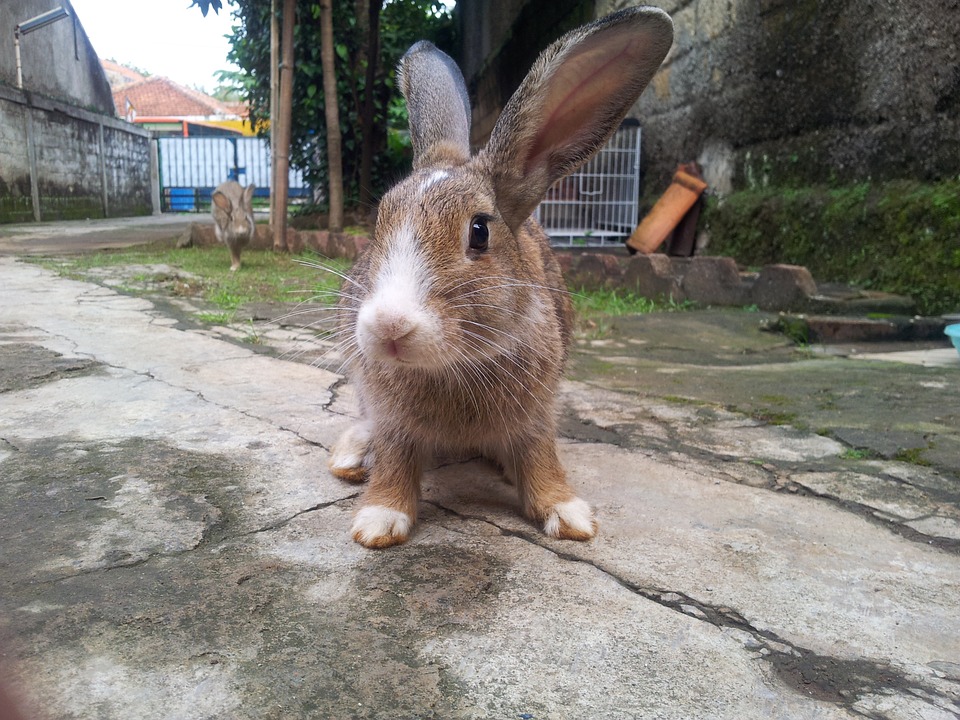This article embarks on a journey into the fascinating world of rabbit communication, demystifying the common misconception that rabbits purr. We'll unveil the true nature of rabbit sounds, including their various vocalizations, physical expressions, and behaviours. We'll also delve into the reasons why rabbits may make certain sounds, what they mean, and how to interpret their intricate language. So, prepare to expand your understanding of these enigmatic creatures and their remarkable ability to communicate.
Part 1: The Persistent Myth of Rabbit Purring

1.1. A Misconception Rooted in Cuteness
The notion that rabbits purr is deeply ingrained in popular culture, often appearing in movies, cartoons, and even perpetuated by some pet owners. This misconception likely stems from our natural tendency to anthropomorphize animals, projecting human traits onto other creatures, especially those we find adorable.
1.2. The Science of Purring: A Cat-Specific Phenomenon
Purring in cats is a complex physiological phenomenon involving the vocal cords and the larynx. It's thought to be a sign of contentment and relaxation. However, rabbits lack the necessary anatomical structures to produce a purring sound. Their vocal cords and larynx are structured differently, limiting their sound-making capabilities.
Part 2: A Chorus of Sounds: Understanding Rabbit Vocalizations

2.1. The Grunt: A Sign of Comfort and Contentment
Rabbits often produce a low, guttural sound known as a grunt. This sound, often described as a soft "mrrr" or "grrr," is typically a sign of contentment, particularly when being petted or groomed. It indicates that the rabbit feels relaxed, safe, and enjoys the attention.
2.2. The Thump: A Warning of Potential Danger
Rabbits also communicate through a distinct sound created by their hind legs hitting the ground. This is known as thumping, and it's usually a sign of alarm or warning, indicating potential danger. A rabbit might thump its feet if it senses a predator, feels threatened, or perceives a change in its environment that causes anxiety.
2.3. Teeth Grinding: A Subtle Sound with a Significant Meaning
While often mistaken for purring, teeth grinding in rabbits is a subtle sound with a significant meaning. It can be a sign of pain or discomfort, particularly in older rabbits experiencing dental issues or other health problems. It's important to pay attention to this sound and consult with a veterinarian if you notice it frequently or in conjunction with other symptoms.
Part 3: Beyond Words: Unraveling Rabbit Body Language
3.1. Ear Position: A Window Into Their Emotional State
Rabbits' ears are highly expressive, conveying a range of emotions through their position. Erect ears typically indicate alertness, while flattened ears suggest fear or aggression. Floppy ears can also signify relaxation or drowsiness.
3.2. Nose Twitching: A Sign of Curiosity and Exploration
A twitching nose in a rabbit is a clear sign of curiosity and exploration. It indicates that the rabbit is investigating its surroundings, sniffing out new smells, or exploring a new object.
3.3. Tail Wagging: A Spectrum of Emotions
Tail wagging in rabbits is not always a sign of happiness, as it is in dogs. A rapid wagging tail can indicate excitement or happiness, while a slow wagging tail can indicate uncertainty or anxiety. It's essential to consider the context and other body language cues to interpret the meaning accurately.
Part 4: Unveiling the Secrets of Rabbit Behaviour
4.1. The Binky: A Joyful Expression of Exuberance
Binkying is a delightful behaviour that exemplifies a rabbit's joy and well-being. It's a joyful leap accompanied by a twist in the air, often with a head flick or a quick kick of the hind legs. Binkying signifies excitement, happiness, and general contentment.
4.2. Licking: A Gesture of Affection and Bonding
Rabbits may lick their owners or other rabbits as a way of bonding and expressing affection. It's a form of grooming behaviour that indicates trust and closeness.
4.3. Flopping: A Sign of Deep Relaxation and Trust
When a rabbit lies on its side with its legs stretched out, it's a sign of deep relaxation and trust. This behaviour, known as flopping, often occurs in safe and comfortable environments, indicating that the rabbit feels secure and content.
Part 5: The Language of Scent: A Silent Form of Communication
5.1. Scent Marking: Establishing Territories and Social Dominance
Rabbits use scent to communicate a variety of messages. They rub their bodies against objects or leave behind urine and faeces to mark their territory and signal their presence to other rabbits. This scent marking plays a crucial role in establishing social hierarchies and communicating dominance.
Part 6. Deciphering Rabbit Communication: Essential Tips and Insights
6.1. Context is King: Interpreting Sounds and Behaviours
To interpret rabbit sounds and behaviours accurately, it's crucial to consider the context. Factors such as environment, social interactions, individual temperament, and even the rabbit's recent history can influence the meaning of a particular sound or behaviour.
6.2. Common Sound Combinations: Unveiling Complex Messages
Rabbits often combine different vocalizations and body language to convey complex messages. For example:
Grunting and ear twitching: This combination indicates curiosity and interest, suggesting that the rabbit is exploring its surroundings or investigating a new object.
Thumping and staring: This pairing is a clear warning signal, indicating that the rabbit is feeling threatened and may be about to attack.
Teeth grinding and leaning away: This combination suggests discomfort or pain, indicating that the rabbit may be experiencing illness or injury.
Part 7: The Importance of Understanding Rabbit Communication
7.1. Building a Stronger Bond: Key to a Happy and Harmonious Relationship
Understanding rabbit communication is essential for building a strong bond with your pet. By recognizing their subtle cues, you can anticipate their needs, address their concerns, and provide them with the care and attention they require.
7.2. Recognizing Health Issues: Early Detection is Key
Certain rabbit sounds and behaviours can be indicators of health problems. If your rabbit is making unusual noises, exhibiting abnormal behaviours, or displaying changes in its usual patterns, it's crucial to seek veterinary advice promptly.
7.3. Ensuring a Safe and Comfortable Environment
By interpreting rabbit communication correctly, you can create a safe and comfortable environment for your pet. You can identify potential threats, address their emotional needs, and prevent unnecessary stress, ensuring their overall well-being.
Part 8: Frequently Asked Questions: Addressing Common Concerns
8.1. Do rabbits purr when they are happy?
No, rabbits do not purr. The misconception of rabbit purring likely stems from teeth grinding, which is a subtle sound sometimes mistaken for purring. However, teeth grinding in rabbits is usually a sign of discomfort or pain, not contentment.
8.2. What does it mean when a rabbit thumps its feet?
Thumping is a warning signal in rabbits. It indicates that the rabbit is feeling threatened or alarmed. It's a way of alerting other rabbits to danger and may also be used to scare away potential predators.
8.3. Why do rabbits grind their teeth?
Teeth grinding in rabbits can be a sign of several things:
Pain or discomfort: It can be a symptom of dental problems, such as overgrown teeth or abscesses.
Stress or anxiety: Rabbits may grind their teeth when they are feeling stressed or anxious, particularly in unfamiliar environments.
Digestive upset: Teeth grinding can also occur in rabbits with digestive problems, such as gas or bloating.
8.4. What are the best ways to communicate with my rabbit?
The best way to communicate with your rabbit is through positive reinforcement. This includes rewarding desired behaviours with treats, praise, and attention. You can also use body language to communicate with your rabbit, such as gentle petting, slow movements, and soft spoken words.
8.5. Can rabbits understand human speech?
While rabbits can learn to recognize their names and respond to simple commands, they don't understand human speech in the same way that humans do. However, they are highly attuned to tone of voice and body language. Using a calm and reassuring voice can help build trust and a sense of safety for your rabbit.
8.6. How can I tell if my rabbit is happy?
There are several signs that indicate a happy rabbit:
Binkying: This is a playful leap in the air, often accompanied by a twist.
Flopping: A rabbit lying on its side with its legs stretched out is a sign of deep relaxation.
Grooming: Rabbits may lick themselves or their owners as a sign of affection.
Grunting: This is often a sign of contentment, especially when being petted or groomed.
Erect ears: Erect ears indicate alertness, but can also signify a happy and curious rabbit.
8.7. Should I be concerned if my rabbit doesn't make any noise?
While some rabbits are naturally quieter than others, a sudden change in vocalization or lack of noise can be a cause for concern. It's important to pay attention to your rabbit's overall behaviour and seek veterinary advice if you notice any changes in their usual patterns.
8.8. How can I learn more about rabbit communication?
There are many resources available to help you learn more about rabbit communication, including:
Books: Numerous books have been written on rabbit behaviour and communication.
Online forums: Online forums dedicated to rabbits provide a platform for owners to share experiences and ask questions.
Veterinarians: Your veterinarian is an excellent source of information on rabbit care and behaviour.
In conclusion, while rabbits do not purr, they have a rich and complex language of their own. By understanding their vocalizations, physical expressions, and behaviours, we can build stronger bonds with our furry friends, ensure their well-being, and create a happy and harmonious living environment for them.
Everyone is watching
-

Do Rabbits Lay Eggs? (The Surprising Truth)
OTHER TYPES OF PETSThis article will unravel the common misconception that rabbits lay eggs, exploring the fascinating world of r...
-

Can Rabbits Eat Grapes? A Guide to Safe Rabbit Treats
OTHER TYPES OF PETSThis comprehensive guide will explore the safety and suitability of grapes for rabbits, providing detailed inf...
-

What's a Group of Rabbits Called? (A Comprehensive Guide)
OTHER TYPES OF PETSThis article delves into the fascinating world of rabbits, exploring the various terms used to describe a grou...
-

Predators That Hunt Rabbits: A Guide to Natural Enemies
OTHER TYPES OF PETSI've always been fascinated by the circle of life, that delicate dance between predator and prey. Growing up ...
-

Are Rabbits Nocturnal Animals?
OTHER TYPES OF PETSThe question of whether rabbits are nocturnal animals is a fascinating one, with a surprisingly complex answer...
